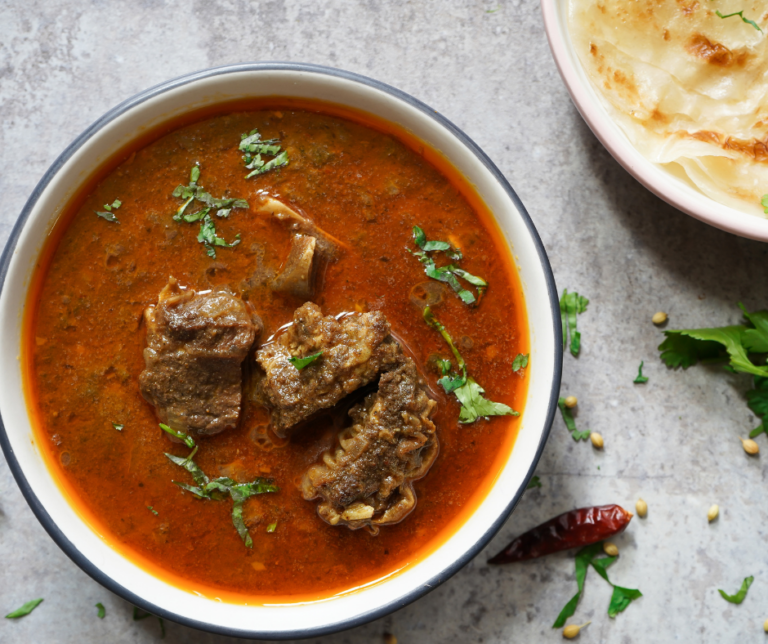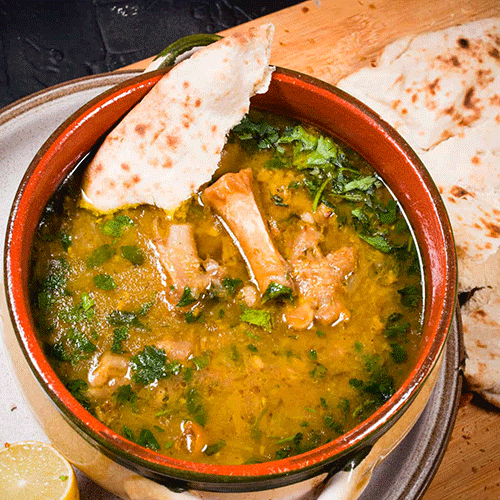Paya is a traditional Pakistani stew made from slow-cooked trotters of a goat, cow, buffalo, or lamb. The recipe delivers a rich and indulgent taste, often savored at breakfast.
Paya, a hearty delicacy, roots deep in Pakistani cuisine, often featuring at festive gatherings and weekend family breakfasts. This stew is a sum of succulent meat and gelatinous bones bathed in a spice-infused broth, simmered to perfection over several hours.
The meticulous slow-cooking process tenderizes the meat and imparts a depth of flavor that makes Paya a beloved comfort food among Pakistanis. The dish is typically garnished with fresh coriander, ginger, and green chilies and served with naan or tandoori roti. Its warmth and richness offer not only a delightful culinary experience but also embody the vibrant culture and hospitable tradition of Pakistan.

The Origins Of Paya
Paya has deep roots in South Asian Cuisine. Originating from the Indian subcontinent, it traditionally consists of spicy goat or cow’s trotters. The trotters are stewed for hours. This creates a rich, flavorful broth.
In Pakistan, Paya holds a special place in local culture. It’s commonly enjoyed on chilly mornings. Families and friends gather to share this hearty, savory dish. Many believe that Paya has health benefits, like stronger joints.
Over time, Paya became a Pakistani culinary staple. It is a highlight during festivals and celebrations. This dish showcases the unique blends of spices that Pakistani cuisine is known for. It’s cherished for its distinctive taste and communal spirit.
Ingredients In The Spotlight
Perfect Paya (Trotters) are essential for authentic taste. Freshness guarantees rich flavor. Choose trotters with clean, white bones. Quality meat cooks into tender delicacies. Let’s talk about spices and seasonings. Traditional Paya recipes blend coriander, cumin, and turmeric. A pinch of garam masala adds warmth.
The aromatic baseline starts with onions. They bring sweetness to the dish. Ginger lends a spicy kick. Don’t forget garlic. Its punch is noticeable. Together, they create an unforgettable aroma. Their combination sets the stage for a delicious meal.
Preparation Secrets Unveiled
Paya Recipe Pakistani delight involves specific steps. Roasting spices properly is key for distinctive flavor. Start with fresh, whole spices. Toast them until aromatic to release flavors. Use a heavy pan on medium heat. Stir constantly to prevent burning.
For the slow cooking methodology, patience is essential. It allows meat to become tender. Use a low flame to simmer paya over hours. This will infuse the meat with spices. The result is a deeply flavorful broth.
To achieve a rich texture, you can use a blend of flour and oil known as roux. Add this mix into the stew. It thickens the liquid, creating a velvety sauce. Smaller paya pieces ensure even cooking and texture.

Variations Across Regions
The Lahore Style Paya charms with bold spices and generous servings of gravy. This city’s love for hearty flavors shines in its Paya. A traditional breakfast favorite, the dish boasts a delectable blend of cardamom, cinnamon, and garam masala. These spices are the soul of Lahore’s recipe.
Karachi’s Coastal Twist adds an innovative touch to the classic Paya. This version gets zing from coastal ingredients – think green chilies and fresh coriander. Sea breeze flavors meet traditional warmth, creating a unique Karachi specialty.
Fusion Paya Innovations fuse global cuisines with local tradition. Think cheese-infused gravy or paya with pasta. Such creativity satisfies the evolving Pakistani palate hungry for global tastes. These Paya variations create a buzz in the food scene, marrying east with west.
Serving The Authentic Paya Experience
Paya, a traditional Pakistani dish, is often enjoyed with a variety of side dishes and accompaniments. Essential for a complete Paya experience are items like fresh naan, tandoori roti, or steamed rice. These staples help soak up the rich, flavorful sauce.
To heighten the taste, a sprinkle of fresh herbs like coriander or mint is recommended. A dash of lemon juice adds a refreshing zing. Condiments such as finely sliced ginger, green chilies, and yogurt are great for a customized spice level.
| Accompaniment | Type | Role |
|---|---|---|
| Naan/Roti | Bread | Soaks sauce |
| Herbs | Fresh | Adds flavor |
| Lemon | Citrus | Brings zing |

Tips And Tricks For A Perfect Paya
Creating the perfect Paya necessitates attention to detail and a keen eye on the cooking process. To ensure success, always use fresh ingredients and clean cuts of meat. It’s important to slow cook the Paya on a low flame, which allows the flavors to meld beautifully.
Avoid overcooking; this can make the meat tough and the broth too thick. For optimal texture and taste, skim the fat occasionally and season carefully.
Storage is simple: let the Paya cool down and store in airtight containers. It can be refrigerated for up to three days or frozen for a month. Always reheat gently to preserve the texture and flavors.
Frequently Asked Questions On Paya Recipe Pakistani
What Is Paya In Pakistani Cuisine?
Paya, derived from the Urdu word for ‘legs,’ refers to a traditional Pakistani stew made using the trotters (feet) of a goat, buffalo, or cow. It is slow-cooked to perfection, often overnight, resulting in a rich, spicy, and hearty broth filled with softened tendons and gelatinous meat.
How Do You Serve Paya?
Paya is commonly served for breakfast or brunch in Pakistan. It’s typically accompanied by naan or another type of bread to soak up the savory broth. Garnishes like sliced ginger, fresh cilantro, and lemon wedges are often provided to enhance the flavor.
What Spices Go Into Paya?
A blend of aromatic spices goes into Paya, including garam masala, turmeric, coriander, and cumin, with additional ingredients like garlic, ginger, and onions for depth. Green chilies can be added for heat, and the dish is often finished with fresh coriander and ghee.
Is Paya A Healthy Dish?
While Paya is rich in certain nutrients like protein and collagen, it is also high in fat, particularly saturated fat. Its healthiness can depend on the preparation method and portion size. However, the collagen might be beneficial for joint health.
Conclusion
Embracing this traditional Paya recipe will transport your taste buds to the heart of Pakistani cuisine. Perfect for any occasion, this dish promises a delightful blend of spices and tenderness. So, gather your ingredients and let the aromas of Pakistan fill your kitchen.
Bon Appétit!

